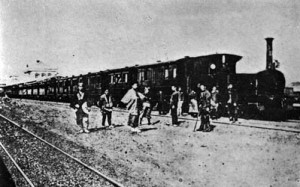Front door of Japan 2015/11/16
It is the season of harvesting rice, the main crop in Japan. It is still believed among religious farmers that ripening of rice is brought by Kamisama (Something extraordinary great). Kamisama stays at paddy fields from the beginning of planting in spring until the end of harvesting in autumn. After harvest, Kamisama has left for a mountain until next spring.
According to the old lunar calendar, 10th month ( around this season) is called as “ Absence of God”. That is probably because Kamisama has been absent from paddy fields. However there is old strong another legend which tells all Kamisamas all over Japan have left their home towns and gathered at Izumo Taisha Shrine to discuss any important issues including matching of young couples.
Izumo Taisha Shrine locates at Japan Sea coast in western Japan. In ancient days, Japan Sea coast was the front door of Japan which faces to Eurasia continent, in other words, an advanced culture or technology. Above legend indicates all powerful men gathered in Izumo, most advanced area in Japan at that time, to study new culture or technology just after a harvest, in other words, during off season of agriculture.
After Meiji Revolution, Japanese government tried hard to develop Pacific Ocean coast instead of Japan Sea coast. For example, the construction of Sanyo railway which runs Pacific Ocean side of western Japan from Kobe to Shimonoseki, west end city of mainland, was completed in 1901, while the construction of Sanin Railway which runs Japan sea side, was finally completed in 1933. It reflected solid determination of the new government to develop preferentially Pacific Ocean side including three major cities, Tokyo, Osaka, Nagoya, by introducing western culture and technology via Pacific Ocean. Pacific Ocean coast has become front door of Japan since then.








